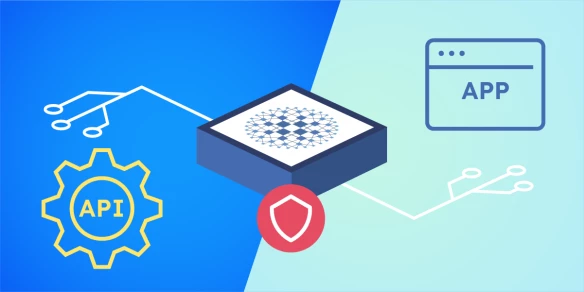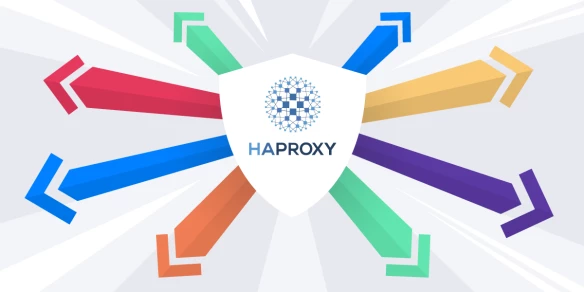
Robust app security is non-negotiable, but the spiraling costs that can come with it are.
In the context of application delivery, security plays a pivotal role in maintaining business continuity, protecting sensitive data, and upholding a solid reputation. However, the journey to build a formidable defense at the load balancing and reverse proxy layer can quickly become costly with a few wrong turns. Security is important, but buyers don’t have to break the bank to implement it.
As they deal with DDoS protection, bot management, web application firewalls, and more, businesses can avoid spiraling security costs by adopting an approach that prioritizes security as standard, simple implementation, efficient performance, and proven success.
Businesses struggle to optimize security costs and extract value
In a recent post on why your load balancer should be fast and flexible, we discussed that IT budgets are expected to increase in 2024 despite economic uncertainty. According to a report by Spiceworks and Aberdeen Strategy & Research, State of IT, one reason for bigger IT budgets is growing security concerns.
However, before investing in new security solutions for your web apps and APIs, buyers should understand the challenges affecting return on investment and the obstacles to implementing a security transformation project. The report shows that tech leaders consider their biggest weaknesses to be maximizing value from vendors, optimizing their IT costs, and proactively preventing issues. When it comes to rating their own performance, only a small proportion of tech leaders excel in these areas, with just 22% excelling in maximizing value from vendors, 24% in optimizing their IT costs, and 25% in proactively preventing issues.
It’s no surprise that businesses face big challenges in getting value for money, with overspending creeping into every stage of the buying and operating cycle.
How app security costs run out of control
Here are the four ways that app security costs can spiral out of control:
Security costs extra. Sometimes the initial solution doesn’t come with security features as standard. To bolster their defenses, businesses end up shelling out extra for web application firewall (WAF), bot management, DDoS protection, authentication, and monitoring. It’s like purchasing a car and having to pay extra for safety features such as seatbelts and airbags that should be included in the original packaging to begin with.
Implementation is difficult. Integrating a security solution that doesn’t fit a business’s unique environment can lead to additional expenses. This solution might come with compatibility issues or a steep learning curve, forcing the business to bring in an implementation partner and invest in professional services to ensure it works effectively in their environment.
Resource use is high. Some security solutions demand a lot of CPU resources to deliver the necessary performance and scale. This can result in unexpected costs, whether purchasing additional servers or a higher public cloud bill.
Security breaches happen anyway. Inflexible, fragmented security might eventually fail when faced with sophisticated threats. When a security breach happens, businesses not only bear the costs of resolving the breach but also the expense of fixing the underlying problem and – in the worst case – seeking and implementing a replacement security solution. Buyers can quickly find themselves trapped in a never-ending nightmare of security costs.

How much are businesses overspending on security?
Businesses are paying tens of billions worldwide for cybersecurity. In many cases, they are spending more than they should.
Gartner estimated that worldwide spending on information security and risk management would grow 11.3% this year to reach $188 billion. Of this, $76 billion was expected to be spent on security consulting and implementation. That’s 40% of this year’s security spending being dedicated to getting solutions working that may not have been suitable for a business in the first place.
Worldwide spending on public cloud services was forecast to total $597 billion in 2023. Despite this massive cost, Forbes argued that 82% of organizations are spending more than necessary to run workloads in the public cloud. Security products deployed as fixed and discrete units fit poorly with elastic scalability and inevitably cost more to run, as does software with poorly optimized CPU usage.
Worst of all, this overspending is not paying off in reduced risk and impact from security threats.
Overspending on security does not lead to better results
Unfortunately, overspending on security does not necessarily lead to better results. According to an Aberdeen cybersecurity expert, “Organizations have made a significant allocation of resources to cybersecurity, but…there’s an unclear connection between activities and results.”
Despite massive investment in security, about 20% of attacker compromises still go undetected and a large data breach involving one million records or more happens each week on average.
This is especially concerning given the consequences businesses face from a security breach. The global cost of a security breach is $4.45 million—and that number climbs to $9.44 million in the U.S.
Since there’s no correlation between spending and results in security and risk management, there’s no reason for businesses to tolerate overspending. Instead, businesses ought to adopt a new approach when procuring security solutions for their application delivery, which prioritizes value for money at all stages of the buying cycle.
Take control of spiraling app security costs
To break the cycle of paying over and over again for security, businesses need a new approach to procuring a solution. It all starts with expecting more from vendors.
Businesses should seek a vendor that considers advanced security as something all businesses should have. Security should be simple and practical. Most importantly, it should deliver the results needed while avoiding costly do-overs. A better approach to app security should:
Offer security as standard. Select an application delivery solution that incorporates enterprise-grade security as an integral component of its offering. Businesses shouldn’t have to resort to costly add-ons or extra expenditures to ensure the safety of their services. App delivery solutions should provide built-in security capabilities allowing businesses to secure their apps effortlessly.
Be simple to implement. Implementing security solutions should be straightforward and hassle-free. The solution should seamlessly integrate into existing infrastructure, eliminating the need for intricate and resource-draining setups. Simplicity should be at the center of security strategy, reducing reliance on external consultants and partners, and allowing businesses to adapt and manage the solution with ease.
Run efficiently. The security solution should provide efficient, scalable performance that adapts to a business’s needs. Whether on-premises or in the cloud, the solution should deliver reliable performance without excessive CPU demands, preventing spiraling operational costs.
Prevent issues later. The track record is everything. The solution should be market-leading technology with enterprise-grade support that won’t ever let the business down. Preventing issues before they occur is the most important component of a cost-effective and solid security strategy.
Finding a security solution that checks these boxes is imperative to taking control of spiraling app security costs. Often, this means consolidating piecemeal, fragmented products into fewer layers.
A consolidated security solution with fewer layers can help keep vendor costs low, reduce the number of integration points, require fewer resources to run, and even reduce latency by having fewer “hops” in the request path.
This approach aligns with a trend noted by Gartner: a movement toward security consolidation. Organizations are increasingly using fewer vendors and are seeing benefits from the decision—improved staff efficiency and integration, along with more features from fewer products.

HAProxy Technologies: modern load balancing and security in one
For businesses eager to break free from the cycle of spiraling costs, HAProxy Technologies emerges as a practical and effective solution.
What sets HAProxy Technologies apart is its approach to security. With HAProxy’s enterprise products, protecting apps isn’t treated as an add-on or extra expense. Instead, they provide security as standard, eliminating the need for supplementary purchases. We see in our G2 reviews that customers value this consolidation, with one reviewer stating HAProxy is not only a load balancer but “an additional tool in a business’s security environment”.
HAProxy was engineered with simplicity in mind, and this has resulted in being awarded the badge “Highest User Adoption” in the G2 Fall 2023 Grid Reports. Customers agree, with one user stating the WAF is “simple and easy to use” compared to other options on the market. Simplicity minimizes the need for partners and lengthy implementation periods. To see how simple HAProxy can be, read I-Track Software’s account of how they implemented HAProxy Enterprise.
One of the reasons why HAProxy earned the “Best Results” badge is its efficient, reliable performance that scales with the business. Whether operating on-premises or in the cloud, HAProxy’s world-leading performance keeps running costs low by using less resources to reach the scale and speed you need. To see what efficient performance looks like, read how HAProxy can handle 2 million requests per second (RPS) on a single Arm-based AWS Graviton2 instance.
Moreover, HAProxy excels in defending against security threats because of its approach to multi-layered security, which includes a web application firewall (WAF), DDoS protection, bot management, access control lists, and rate limiting. The end result: multiple security features that fit and communicate together to make fast and accurate decisions—integral to avoiding costly security breaches. The ability to serve many different functions is the reason why HAProxy has been recognized as a leader across so many categories.
Customers place a lot of trust in HAProxy Technologies’ authoritative team of engineers, who help implement and optimize HAProxy deployments to the highest standard. HAProxy is known for the quality of its products and customer support—it’s why we’ve received the “Best Relationship” badge.
Case study: Reducing complexity to a single, powerful solution
HAProxy’s customer success stories showcase the importance of approaching security from a different angle.
In the case of True.nl, its advanced security platform struggled with complexity and performance. These issues were a result of a fragmented security approach, leveraging multiple solutions to ensure there were no gaps in their defense.
Unfortunately, this approach was resource-intensive and resulted in overlapping security features that were far from cost-effective. True.nl knew it needed to simplify its security approach and consolidate various security features into a single, powerful solution—and that solution was HAProxy Enterprise.
HAProxy Enterprise offered everything True.nl needed to enhance its secure, modern hosting platform: active health checks, hitless reloads, a robust WAF solution, a JavaScript challenge module, and more reliable rate limiting. The best part? They didn’t need to rely on another solution to fill in the gaps, reducing the complexity of their platform.
Implementation was simple with help from the HAProxy team, which included adding a reCAPTCHA module on request.
Consolidating their security solution into one layer with HAProxy Enterprise also improved performance – and their performance monitoring capability.
HAProxy soon became True.nl’s versatile solution for its advanced security platform. With no feature-gating, fast implementation, and improved performance, True.nl didn’t have to worry about overspending on security.
Conclusion
Fragmented, complicated, and inefficient security can trap businesses in a cycle of spiraling costs. To avoid overspending, businesses should reevaluate their security vendors and prioritize a more cost-effective approach.
Solutions that prioritize security as standard, simple implementation, efficient performance, and proven results can help businesses break free from the cycle of spiraling security costs.
HAProxy’s enterprise product suite checks these boxes and more, empowering businesses to secure their applications and APIs efficiently, cost-effectively, and with confidence.
Subscribe to our blog. Get the latest release updates, tutorials, and deep-dives from HAProxy experts.




